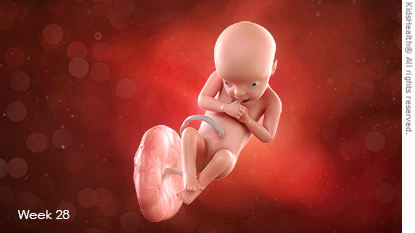- Home
- Humana Medicaid
- Kentucky Medicaid
- Medicaid extras
- Health and wellness
- Parents Home
- Para Padres
- A to Z Dictionary
- Allergy Center
- Asthma
- Cancer
- Diabetes
- Diseases & Conditions
- Doctors & Hospitals
- Emotions & Behavior
- First Aid & Safety
- Flu (Influenza)
- Food Allergies
- General Health
- Growth & Development
- Heart Health & Conditions
- Homework Help Center
- Infections
- Newborn Care
- Nutrition & Fitness
- Play & Learn
- Pregnancy Center
- Preventing Premature Birth
- Q&A
- School & Family Life
- Sports Medicine
- Teens Home
- Para Adolescentes
- Asthma
- Be Your Best Self
- Body & Skin Care
- Cancer
- Diabetes
- Diseases & Conditions
- Drugs & Alcohol
- Flu (Influenza)
- Homework Help
- Infections
- Managing Your Weight
- Medical Care 101
- Mental Health
- Nutrition & Fitness
- Q&A
- Safety & First Aid
- School, Jobs, & Friends
- Sexual Health
- Sports Medicine
- Stress & Coping
Pregnancy Calendar: Week 28
Your Baby's Development
Your baby now weighs about 2 pounds, 2 ounces (1,000 grams) and measures  about 10 inches (25 cm) from crown to rump. The folds and grooves of your baby's brain are still developing and expanding, and your baby's adding layers of fat.
about 10 inches (25 cm) from crown to rump. The folds and grooves of your baby's brain are still developing and expanding, and your baby's adding layers of fat.
At your next prenatal visit, your health care provider may tell you whether your baby is headfirst or feet- or bottom-first (called breech position) in the womb. Babies who are in the breech position may need to be delivered by C-section. Your baby still has 2 months to change position, though, so don't worry if your baby is in the breech position right now. Most babies will switch positions on their own.

Your Body
 Your health care provider probably sent you for some blood tests early in your pregnancy. One thing blood tests measure is the Rh factor, a substance found in the red blood cells of most people. If you don't have it (if you're Rh negative) but your baby does (is Rh positive), there's the potential for your baby to have health problems, such as jaundice and anemia. Your doctor can prevent these problems by giving you Rh immune globulin shots this week and again after delivery.
Your health care provider probably sent you for some blood tests early in your pregnancy. One thing blood tests measure is the Rh factor, a substance found in the red blood cells of most people. If you don't have it (if you're Rh negative) but your baby does (is Rh positive), there's the potential for your baby to have health problems, such as jaundice and anemia. Your doctor can prevent these problems by giving you Rh immune globulin shots this week and again after delivery.

© 1995- The Nemours Foundation. KidsHealth® is a registered trademark of The Nemours Foundation. All rights reserved.
Images sourced by The Nemours Foundation and Getty Images.